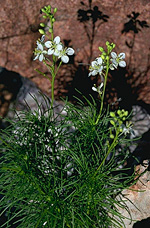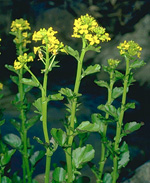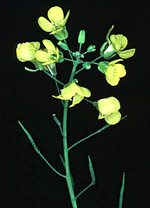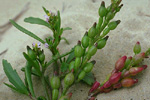 |
This is a large, almost cosmopolitan, mainly temperate family. Many species of Brassicaceae in Australia are introduced weeds of disturbed places. Native species occur from the arid plains to the high alps and coastal strandlines. Few species occur in the tropics or in closed forests.
Characteristic features of the family Brassicaceae in Australia include: - almost all are soft herbs, often annual or short-lived, but a few are shrubby
- leaves are alternate and simple or deeply lobed, often with a mustard or cabbage smell
- flowers are usually white, yellow or pink with four, free petals
- the arrangement of stamens is characteristic: there are almost always 6 stamens in 2 whorls, an outer whorl of 2 short stamens, and an inner whorl of 4 longer ones
- fruits are short or elongate, flattened or cylindrical 2-valved capsules, the valves falling to leave exposed a persistent, thin, often white false septum
Description
Evergreen shrubs or annual, biennial or perennial terrestrial herbs or aquatic herbs rooted in the substrate with their leaves floating or emergent, perennating by rhizomes or taproots. Vegetative reproduction absent or by rhizomes. Stem internodes solid or rarely hollow. Internal secretions not obvious. Plants glabrous or with simple, dendritic or stellate, non-glandular, unicellular hairs. Leaves alternate and spiral, or if herbs then the leaves cauline, all or mostly basal, or both basal and cauline, petiolate, subsessile or sessile. Stipules and stipellae absent. Lamina simple or once compound, imparipinnate, symmetric, pinnatifid or pinnatisect; lamina/leaflets filiform, acicular, subulate, linear, lanceolate, ovate, elliptic, oblanceolate, ovate, oblong, spathulate or orbicular; base cuneate, attenuate, rounded, cordate or lobed or auriculate; margins entire, crenate, dentate, serrate or sinuate, ±flat, revolute, ?recurved or undulate; one-veined, or the venation pinnate, with the midrib conspicuous or inconspicuous, and the tertiary venation reticulate or not; surfaces not punctate; herbaceous or leathery, rarely succulent; distinctive odour absent or foetid. Plants with all the flowers bisexual. Inflorescences terminal or axillary, consisting of ?spikes, racemes, panicles or corymbs. Bracts present or absent. Pollination by insects. Flowers odourless or fragrant, ?sessile or stalked. Floral disc present; nectaries present on the disc. Perianth regular, of 2 dissimilar whorls, imbricate in bud. Calyx segments free, with 4 sepals, herbaceous; base with wings or other appendages, or without appendages. Corolla segments free, with (0 or) 4 petals, alternating with the sepals, white, cream, yellow, pink, magenta, purple, violet, green or brown, without contrasting markings, or streaked, spotted, etc, membranous; claws present or absent; lobes ±entire, or notched, emarginate, bifid, bilobed, ciliate or fimbriate. Fertile stamens 6, rarely 2 or 4, opposite to the sepals, free of the corolla, free of the ovary and style, distinct from each other, in equal pairs or 4 long and 2 short. Anthers dorsifixed or basifixed, not versatile or rarely versatile, opening inwards by longitudinal slits; 2-celled. Ovary superior and sessile. Carpels (1–) 2, fused; ovary with (1–) 2 locules. Style terminal, single and unbranched and the stigma capitate or 2-lobed. Ovules 1–numerous per locule, stalked or sessile; placentation apical or parietal. Fruit dry, dehiscent or rarely indehiscent, a specialised septicidal capsule (siliqua), sometimes with explosive dehiscence, rarely a nut; the perianth on the maturing fruit deciduous. Disseminule macro-surface featureless, or winged, costate, often with mucilage when wetted; micro-surface ±smooth or reticulate, brown, grey or black, without contrasting markings, or conspicuously patterned, glossy or dull. Seeds 1–numerous per fruit. Aril absent. Cotyledons 2. Embryo sharply bent or coiled.
(Note: this description has been generated from the coded data compiled for the key. Any errors in the key data will be reflected in the descriptions.)
A treatment of the family Brassicaceae has been published in:
Flora of Australia 8: 231-357.
Australian genera of Brassicaceae (as recognised for the Flora of Australia)
† = some species native, others introduced
* = all species introduced
*Alyssum
Arabidella
*Arabidopsis
Arabis
Ballantinia
†Barbarea
Blennodia
*Brassica
*Cakile
*Calepina
*Camelina
*Capsella
†Cardamine
*Cardaria
Carinavalva
*Carrichtera
Cheesemania
*Chorispora
*Conringia
*Coronopus
*Crambe
Cuphonotus
Cyclospermum
*Descurainia
*Diplotaxis
*Draba
Drabastrum
*Erophila
*Eruca
*Erysimum
*Euclidium
Geococcus
Harmsiodoxa
*Heliophila
*Hirschfeldia
Hutchinsia
*Hymenolobus
*Iberis
Irenipharsus
†Lepidium
*Lobularia
*Lunaria
*Malcomia
*Matthiola
Menkea
Microlepidium
*Myagrum
*Nasturtium
*Neslia
Pachymitus
Phlegmatospermum
*Raphanus
*Rapistrum
†Rorippa
Scambopus
*Sinapis
*Sisymbrium
Stenopetalum
*Teesdalia
*Thlaspi
*Turritis

|
  |

Arabidella trisecta (flowering plant)
Photo: M.Fagg © M.Fagg

Barbarea australis (flowers)
Photo: M.Fagg © ANBG

Brassica sp. (flowers)
Photo: M.Fagg © ANBG

Cakile edentula (flowers and fruit)
Photo: G.Leiper © G.Leiper

|
 |
|